
|
 |
- HealthCare Wide Hazards Module -
Ergonomics
Click on the area for more specific information.

|
Common safety and health topics:
Ergonomics is the science of fitting the job to the worker. When there is a mismatch between the physical requirements of the job and
the physical capacity of the worker, work-related musculoskeletal disorders (MSDs) can result. Ergonomics is the practice of designing
equipment and work tasks to conform to the capability of the worker, it provides a means for adjusting the work environment and work
practices to prevent injuries before they occur. Health care facilities especially nursing homes have been identified as an environment
where ergonomic stressors exist.
|
Potential Hazard
Employee exposure to work related MSDs from ergonomic stressors that have not been effectively identified and addressed in a facilities
safety and health program.
-
Many patients/residents (especially nursing home residents) are totally dependent on staff members to provide activities of daily living, such as
dressing, bathing, feeding, and toileting. Each of these activities involve multiple interactions with handling or transferring of patients/residents
and could result in employee injuries. Employee injuries lead to increased injury costs, higher turnover rates, increased sick/injured days,
and staffing shortages.
Possible Solutions
Management Leadership/Employee Participation:
- Management Leadership should demonstrate a commitment to reduce or
eliminate patient/residents handling hazards through establishing a written program that addresses issues, such as:
- Continued training of employees in injury prevention.
- Methods of transfer and lifting to be used by all staff.
- Compliance with transfer and lift procedures.
- Procedures for reporting early signs and symptoms of back pain and other musculoskeletal injuries.
- Employee Participation
should include:
- Complaint/suggestion program which includes employee reports of unsafe working conditions.
- Prompt reporting of signs and symptoms as well as injuries.
Workplace Analysis to identify existing and potential
workplace hazards and find ways to correct these hazards. Assessment of work tasks involves an examination of duration, frequency, and
magnitude of exposure to ergonomic stressors such as force, repetition, awkward postures, vibration and contact stress to determine if
employees are at risk of pain or injury. Observation, workplace walkthroughs, talking with employees and periodic screening surveys are
used to help identify hazards such as stressful tasks.
Accident and Record Analysis: Records of
injuries and illnesses should be analyzed to identify patterns of injury that occur over time, enabling the hazards to be addressed and
prevented. This includes reviewing OSHA 300 logs, OSHA 301 forms and Workers' Compensation reports.
Hazard Prevention and Control including
implementing administrative and engineering controls.
- Administrative controls: Provide for adequate staffing, assessment of patient/residents needs, and restricted admittance policies.
- Engineering controls: Help to isolate or remove the hazards from the workplace, for example providing proper selection, training, and
use of assist devices or equipment (see
Patient Handling
Controls Section).
Medical Management: A medical management program,
supervised by a person trained in the prevention of musculoskeletal disorders, should be in place to manage the care of those injured. The
program should:
- Accurate injury and illness recording.
- Early identification and treatment of injured employees.
- "Light duty" or "no lifting" work restrictions during recovery periods.
- Systematic monitoring of injured employees to identify when they are ready to return to regular duty.
Training: A training program, designed and implemented by qualified
persons, should be in place to provide continual education and training about ergonomic hazards and controls to
managers, supervisors and all healthcare providers, including "new employee" orientation. Training should be updated and presented
to employees as changes occur at the workplace, and be at a level of understanding appropriate for those individuals being trained, and
should also include:
- The opportunity to ask questions of the trainer.
- An overview of the potential risks, causes, and symptoms of back injury and other injuries. Be able to identify existing ergonomic
stressors and methods of control, such as the use of engineering, administrative, and work practice controls particularly safe resident
handling techniques.
- Recognizing the signs and symptoms of MSDs and the procedures for reporting potential problems.
- Encouragement of staff physical fitness.
- Lifting guidelines for health care workers (nurse assistants, licensed practical nurses, registered nurses)
which should include:
- Never transfer patients/residents when off balance.
- Lift loads close to the body.
- Never lift alone, particularly fallen patients/residents, use team lifts or use mechanical assistance.
- Limit the number of allowed lifts per worker per day.
- Avoid heavy lifting especially with spine rotated.
- Training in when and how to use mechanical assistance.
Additional Information:
|
According to the Bureau of Labor Statistics employees in nursing and personal care facilities suffer over 200,000 work-related injuries and
illnesses a year. Many of these are serious injuries. More than half require time away from work. Worker's compensation costs for the
industry now amount to nearly $1 billion per year. Workers in nursing homes are 2x as likely as other workers to be injured on the job.
|
Potential Hazard
Employee exposure to injury from ergonomic stressors
during handling, transferring and repositioning patients/residents.
Patient handling tasks pose increased ergonomic risk
if they are:
-
repetitive (e.g., repeatedly cranking manual adjustments for beds),
-
done in awkward postures (e.g., reaching across beds to lift patients/residents)
-
done using a great deal of force (e.g., pushing chairs or gurneys across
elevation changes or up ramps),
-
lifting heavy objects (e.g., manually lifting immobile patients/residents alone) or
-
combining these factors.
Other hazards include:
- Overexertion; trying to stop a patient/residents from falling or picking patient/residents up from floor or bed.
- Multiple lifts per shift (more than 20).
- Lifting alone, no available staff to help.
- Lifting un-cooperative, confused patients/residents.
- Lifting patients/residents that cannot support their own weight.
- Patient/residents weight (bariatric patients/residents)
- Expecting employees to perform work beyond their physical capabilities.
- Distance to be moved, and the distance the patient/residents is from the employee, (it is more stressful to reach away from the body to lift or
pull a patient/residents).
- Awkward postures required by the activity.
- Ineffective training of employees in body mechanics and proper lifting techniques.
Possible Solutions
- Facilities should establish a safety and health program that addresses patient/residents handling hazards and establishes patient/residents handling
criteria:
- Guidelines for Nursing Homes
Section III Identifying Problems and Implementing Solutions for Resident Lifting and Repositioning includes an assessment of resident handling
tasks that can help to determine the safest methods for performing necessary tasks for individual patients/residents without injuring workers for
example:
- FIGURE 1. Transfer to and from: Bed to Chair, Chair to Toilet, Chair to Chair, or Car to Chair.
- FIGURE 2. Lateral Transfer to and from: Bed to Stretcher, Trolley
- FIGURE 3. Transfer to and from: Chair to Stretcher
- FIGURE 4. Reposition in Bed: Side–to-Side, Up in Bed
- FIGURE 5. Reposition in Chair: Wheelchair and Dependency Chair
- FIGURE 6. Transfer a Patient/residents Up From The Floor
- A list of sample equipment solutions for resident lifting and repositioning tasks are also included.
- OSHA recommends minimizing manual lifting of patients/residents in all cases and eliminating lifting when possible. Example patient/residents handling
controls are listed below.
|
|
Patient Handling Controls
|
Potential Hazard
Employee exposure to injury from ergonomic stressors during handling, transferring and
repositioning of patients/residents. Hospital health care workers
(especially nursing assistants, who do a majority of the lifting in many
facilities) may develop musculoskeletal injuries such as muscle and ligament
strain and tears, joint and tendon inflammation, pinched nerves, herniated discs
and others from patient/residents handling.
Possible Solutions
Good work practice includes continually identifying the most hazardous tasks and implementing engineering and work
practice controls to help reduce or prevent injuries in those tasks. Remember
OSHA
recommends minimizing manual lifting of patients in all cases and eliminating lifting when possible.
| |
- Provide employees with proper assist devices and equipment to reduce excessive lifting hazards.
- Proper equipment selection depends on the specific needs of the facility, patients/residents, staff, and management.
|
| |
For example, implement the use of:
|

|
- Devices such as shower
chairs
that fit over the toilet, using this device can eliminate multiple transfers, saving health care workers multiple lifts. A patient/residents can be
moved to the shower chair, toileted, showered, and transferred back to the wheelchair.
|

|
- Shower stalls that allow for shower chairs to be pushed in and out on level floor surfaces. This is a standard
shower without the front lip to allow for easy access.
|
| |
|
| |
- Toilet seat risers: Use toilet seat risers on toilets to equalize the height of wheelchair and toilet seat,
making it a lateral transfer rather than a lift up and back into wheelchair.
|

|
- Mechanical lift equipment to help lift patients/residents who cannot support their own
weight. Choose a lift that does not require manual pumping to avoid possible repetitive motion disorders to workers' arms or shoulders.
Lift equipment can be categorized into 2 main categories:
|
| |
-
Overhead
track mounted
patient lifters:
A tract system built into the ceiling that sling lifts attach to. This system provides patient/residents mobility from room to room without manual
lifting.
|
| |
-
Lateral transfer devices: Devices used to laterally transfer a patient/residents for example from bed to gurney. They usually involve multiple staff
members to help do the lifting. This is often done with the help of a draw sheet, or similar device. Some new lateral transfer systems do
not require any lifting by staff, and are totally mechanical. This type of device helps prevent staff back injuries.
|

|
- Sliding boards: A slick
board used under patients/residents to help reduce the need for lifting during transfer of patient/residents from bed to chair, or chair to car. Patients/residents are
slid rather than lifted.
|
| |
-
Slip sheets/Roller sheets:
Help to reduce friction while laterally transferring patients/residents or repositioning patients/residents in bed and reduce the force workers need to exert
to move the patient/residents.
|
| |
-
Repositioning Devices: Mechanically pulls patient/residents up in bed
eliminating manual maneuvering by staff.
|

|
- Height adjustable electric beds
that have height controls to allow for easy transfers from bed height to wheelchair height. These beds can be kept low to the ground for
patient/residents safety and then raised up for interaction with staff. Avoid hand cranked beds, which can lead to wrist/shoulder musculoskeletal
disorders such as strain or repetitive motion injuries.
|

|
- Trapeze lifts: A bar device suspended above the bed which allows patients/residents with upper
muscle strength to help reposition themselves. This device is particularly useful with adjustable beds and armless wheelchairs.
|

|
- Walking
belts or gait belts (with handles) that provide stabilization for ambulatory patients/residents by allowing workers to hold onto the belt
and support patients/residents when walking. Not designed for lifting patients/residents.
|

|
- Wheelchairs with removable arms to allow for easier lateral
transfers. Especially useful with height adjustable beds.
|
| |
- Descent Control System (DCS): Emergency evacuation or retrieval from older or
disabled structures may require using stairs or negotiating rough terrain when
moving patients. These devices allow ambulance technicians or emergency
evacuation personnel to safely move a loaded hospital cot or gurney down stairs
or any steep decline. The Device easily attaches to any ambulance cot currently
in the pre-hospital care market. When not in use, the DCS simply folds up and
out of the way.
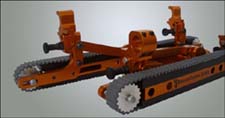
Descent Control System |
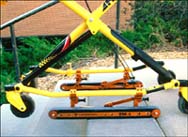
Descent Control System
attached to cot |
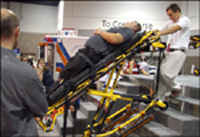
Demonstration of Descent Control System on stairs |
|
| |
- Patient care plans: A written care plan that describes specific patient/residents needs,
degree of assistance required, special treatments etc. Possible scenarios include:
|

|
- color coding of patient/residents lift requirements for posting at bedside. By simply looking at displayed color coding system an employee can
know what kind of assistance the patient/residents will need with moving or transfers.
|
| |
- segregation of patients/residents based on need so equipment and trained staff are appropriately assigned.
|
| |
- staggered staffing to provide additional manpower for peak periods.
|
| |
- Roll on weight scale: Patients/residents who cannot stand can be weighed in their wheelchairs.
|
| |
- Pivot transfer disk
devices: Used for standing pivot transfers and seated pivot transfers for patients/residents that have weight bearing capacity and are
cooperative.
|
| |
|
| |
-
Back belts: The effectiveness of back belts in reducing the risk of back injury among healthy workers remains
unproven.
- If workers falsely believe that they are protected when wearing belts they may attempt to lift more weight than they would have without
a belt, risking potential injury (See
Backbelts:
Do They Prevent Injury? (DHHS) (NIOSH) Publication No. 94-127).
|
|
|
Trips/Slips/Falls
|
Potential Hazard
|
Trip/slips and falls from spills or environmental hazards. |
| |
- Environmental hazards such as:
|
| |
|
| |
|
| |
- Lifting in confined spaces.
|
| |
- Cluttered or obstructed work areas/passageways.
|
| |
- Poorly maintained walkway or broken equipment.
|
| |
- Inadequate staffing levels to deal with the workload, leading to single person lifts and greater chances of falls.
|

|
- Inadequate lighting, especially during evening shifts.
|
Possible Solutions
Good work practice includes implementing engineering and work practices controls to help prevent slips/falls such
as:
|
| |
- Eliminate uneven floor surfaces.
|
| |
- Create non slip surfaces in toilet/shower areas.
|
| |
- Immediate clean-up of fluids spilled on floor.
|
| |
- Safely working in cramped working spaces-avoiding awkward positions, using equipment that makes lifts less awkward.
|
| |
- Eliminate cluttered or obstructed work areas.
|
| |
- Provide adequate staffing levels to deal with the workload.
|
|
|
Awkward Postures
|
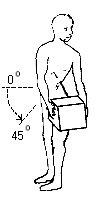
Twisting while lifting
|
Awkward postures occur with twisted, hyper-extended or
flexed back positions. They are unsafe back postures for patient/residents
lifting. |
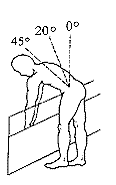
Back flexion
|
Potential Hazard
Increased potential for employee injury exists when
awkward postures are used when handling or lifting patients/residents.
Awkward postures include:
| |
|
| |
|
| |
|
| |
- Back hyperextension or flexion.
|
| |
- Forces on the spine increase when lifting, lowering or handling objects with the back bent or twisted. This occurs because the muscles
must handle your body weight in addition to the weight of the patient/residents being lifted.
|
| |
- More muscular force is required when awkward postures are used because muscles cannot perform efficiently.
|
| |
- Fixed awkward postures (i.e., holding the arm out straight for several minutes) contribute to muscle and tendon fatigue, and joint
soreness.
|
| |
- To be considered a risk factor, awkward postures need to last more than 1 hour continuously or for several hours in the
work shift.
|

|
- Reaching forward or twisting to support a patient/residents from behind to assist them in walking.
|
Possible Solutions
Good work practice recommends avoiding awkward postures
while lifting or moving patients/residents.
- Educate and train employees about safer lifting techniques.
- Use assist devices or other equipment whenever possible.
- Team lifting based on assessment.
|
|
For more information see:
Guidelines for Nursing Homes.
|
Potential Hazard
Employee exposure to ergonomic stressors in healthcare
workplaces occurs not only during patient/residents
handling tasks but while performing other tasks as well in the kitchen, laundry,
engineering, and housekeeping areas of facilities, for example during:
- transporting of equipment, moving food carts or other heavy carts, pouring liquids out of heavy pots or containers, reaching into deep
sinks or containers, using hand tools, and during housekeeping tasks.
Possible Solutions
-
Use engineering or work practice techniques to eliminate the hazard or decrease the hazard for example:
|
Transferring Equipment: Strains and sprains can occur if employee is transferring equipment
like iv poles, wheelchairs, oxygen canisters, respiratory equipment, dialysis equipment, x-ray machines, or multiple items at the same time.
To reduce the hazards of transferring equipment:
|
- Place equipment on a rolling device if possible to allow for easier transport, or have wheels attached to the equipment.
- Push rather than pull equipment when possible. Keep arms close to your body and push with your whole body not just your arms.
- Assure that passageways are unobstructed.
- Attach handles to equipment to help with the transfer process.
- Get help moving heavy or bulky equipment or equipment that you can't see over.
- Don't transport multiple items alone for example if moving a patient/residents in a wheelchair as well as an iv pole and/or other equipment get
help, don't overexert yourself.
|
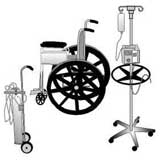
|
|
Reaching into deep sinks or containers: If washing dishes, laundry, or working in maintenance
areas and using a deep sink, limit excessive reaching and back flexion by:
|
-
Placing an object such as a plastic basin in the bottom of the sink to raise the surface up while washing items in the sink or
-
Remove objects to be washed into a smaller container on the counter for scrubbing or soaking and then replace back in the sink for final rinse.
|
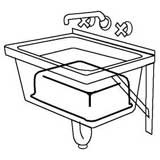
|
|
Limit reaching or lifting hazards when lifting trash, laundry or other kinds of bags by:
|
- Using handling bags for laundry, garbage, and housekeeping when possible that have side openings to allow for easy disposal without
reaching into and pulling bags up and out. The bags should be able to slide off the cart without lifting.
- Limiting the size and weight of these bags and provide handles to further decrease lifting hazards.
- Using garbage cans that have a frame vs. a solid can to prevent plastic bags from sticking to the inside of the can or use products
that stick to the inside of the garbage can that prevent the bag from sticking.
- Limit the size of the container to limit the weight of the load employee must lift and dump.
- Place receptacles in unobstructed and easy to reach places.
|
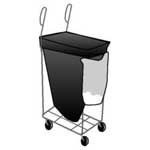
Handling Bag |
- Installing chutes and dumpsters at or below grade level.
- Using spring-loaded platforms to help lift items such as laundry keeping work at a comfortable uniform level.
|
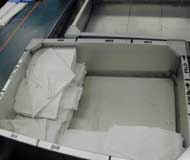
Spring Loaded Platform
|
Limit reaching and pushing hazards from moving heavy dietary, laundry, housekeeping or other carts by:
|
- Keeping carts, hampers, gurneys, or other carts well maintained to minimize the amount of force exerted while using these items.
- Using carts with large, low rolling resistance wheels. These can usually roll easily over mixed flooring as well as gaps between elevators
and hallways.
- Keeping handles of devices to be pushed at waist to chest height.
- Using handles to move carts rather than the side of the cart to prevent the accidental smashing of hands and fingers.
- Keeping floors clean and well maintained.
- Pushing rather than pulling whenever possible.
- Removing from use all malfunctioning carts.
- Getting help with heavy or bulky loads.
|
 |
Using Hand Tools in maintenance areas:
Limit strains and sprains of the wrists, arms, and shoulders, of maintenance workers by choosing hand tools carefully
hand tools should:
|
- Be properly designed, and fit to the user.
- Have padded non-slip handles.
- Allow the wrist to remain straight while doing finger intensive tasks. Select ergonomic tools such as ergonomic knives or bent-handled
pliers.
- Have minimal tool weight.
- Have minimal vibration or use vibration dampening devices and vibration-dampening gloves.
|

|
- Use trigger bars rather than single finger triggers.
- Not be used when performing highly repetitive manual motions by hand, use power tools (e.g., use power screwdrivers instead of manual
screwdrivers).
|

Trigger bar |
Housekeeping Tasks: To decrease ergonomic stressors when employees are performing cleaning
tasks employees should: |
- Alternate leading hand.
- Avoid tight and static grip and use padded non-slip handles.
- Clean objects at waist level if possible, rather than bending over them (e.g., push wheelchairs up a ramped platform to perform
cleaning work, or raise beds to waist level before cleaning).
- Use knee pads when kneeling.
|
 |
- Use tools with extended handles, or use step stools or ladders to avoid or limit overhead reaching.
- When sweeping or dusting use flat head dusters and push with the leading edge; sweep all areas into one pile and pick up with a vacuum.
- Use chemical cleaners and soaks to minimize force needed for scrubbing.
- Frequently change mopping styles when mopping (e.g., push/pull, figure 8, and rocking side to side) to alternate stress on muscles.
- Be sure buckets, vacuums, and other cleaning tools, have wheels or are on wheeled containers with functional brakes.
- Alternate tasks or rotate employees through stressful tasks.
- Avoid awkward postures while cleaning (e.g. twisting and bending).
- Use carts to transport supplies rather than carrying.
- Use buffers and vacuums that have lightweight construction and adjustable handle heights.
- Use spray bottles and equipment that have trigger bars rather than single finger triggers.
|

|
|
OSHA issued a revised Recordkeeping Rule to
improve the system employers use to track and record workplace injuries and illnesses. Final rule became effective on Jan. 1, 2002.
|
Potential Hazard
Without proper recordkeeping, illness and injury trends would go unreported and unstudied and valuable information
about causes and possible prevention of injuries would be lost.
Possible Solutions
-
Follow the Recordkeeping
Standard.
-
Employers must record each fatality, injury or illness that:
-
Is work related, and
-
Is a new case, and
-
Meets one or more of the criteria contained in sections 29 CFR 1904.7 through 1904.12 of the regulation.
-
Exposure to ergonomic stressors in healthcare workplaces can result in a variety of disorders in affected workers referred to as musculoskeletal
disorders (MSDs). MSDs may develop gradually over time or may result from instantaneous events such as a single heavy lift. These conditions
will be classified on recordkeeping forms as either injuries or illnesses. It is critical for recording keeping data to be kept accurately
and that employers do not under report these events.
-
OSHA offers EXCEL worksheet versions of the OSHA 300, 300A and
30l forms for health care facilities who have computer access.
-
OSHA's FAQ for Recordkeeping.
-
How to
Decide if a particular injury is reportable - Table and Decision Tree.
-
Recordkeeping
Policies and Procedures Manual CPL 2-0.131 (2002, January 1).
-
Recordkeeping, Safety and Health
Topics Page.
|
|

